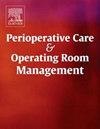Economic value of using electronic transporter applications for post-anesthesia care unit staffing decisions rather than manual logging of transport durations
IF 1
Q2 Nursing
Perioperative Care and Operating Room Management
Pub Date : 2025-03-23
DOI:10.1016/j.pcorm.2025.100486
引用次数: 0
Abstract
Background
Recently, we used data from Epic's Rover Transport application to analyze patient discharges from a phase I post-anesthesia care unit (PACU). We perform a retrospective cohort study to analyze how and when to use transporter log data to appropriately balance Type I and Type II error rates in the context of PACU transporter staffing decision-making.
Methods
The Rover Transport app was used to track all PACU transports from July 2022 through April 2024, totaling 22,846 across 461 workdays. The total hours of PACU transport follow a trapezoidal pattern, with load increasing through the morning (08:00–11:59), plateauing in the afternoon and evening (12:00–15:59 and 16:00–19:59), and then decreasing at night (20:00–23:59). Each transporter spends approximately one hour per four-hour period transporting. To inform transporter staffing decisions from these data, pairwise comparisons were generated between each workday's “light” periods (08:00–11:59 vs 20:00–23:59) and “busy” periods (12:00–15:59 vs 16:00–19:59). The probability distribution of these pairwise comparisons were compared with normal distributions using Shapiro-Wilk tests and standardized normal probability plots. Then, for repeated statistical power analyses to guide PACU transporter staffing, Type II errors were considered at least as costly as Type I errors. Setting α = β = 0.05, we determined how many days of data were required to differentiate between the “light” periods (08:00–11:59 vs 20:00–23:59) and the “busy” periods (12:00–15:59 vs 16:00–19:59), using the minimum actionable difference of one hour per four-hour period.
Results
Both pairwise comparisons were normally distributed (Shapiro-Wilk W > 0.99). At α=β=0.05, proper differentiation of hours of PACU transport workload between four-hour periods required total transport data from at least 18 out of every 100 workdays for the “light” four-hour periods, or 44 out of every 100 workdays for the “busy” four-hour periods. Relaxing the combined error rate to 0.15 reduced the day requirements to 36 and 15. Restricting the combined error rate to 0.02 required 80 and 32 days of data for comparison between “busy” and “light” four-hour periods respectively.
Conclusions
The number of days of data needed for statistically powerful comparisons between four-hour period workloads are prohibitively large for manual collection. Therefore, hospitals not yet using the transport tracking capabilities in their electronic medical records for PACU transports will benefit from using them, even if only for the improved staffing decisions the data allows.
在麻醉后护理单位人员配置决策中使用电子传送器的经济价值,而不是手工记录传送持续时间
最近,我们使用Epic的Rover Transport应用程序的数据来分析I期麻醉后护理病房(PACU)的患者出院情况。我们进行了一项回顾性队列研究,以分析在PACU运输人员配备决策的背景下,如何以及何时使用运输人员日志数据来适当地平衡I型和II型错误率。使用Rover Transport应用程序跟踪2022年7月至2024年4月期间PACU的所有运输,在461个工作日内总计22,846次运输。PACU运输总小时呈梯形,上午(08:00-11:59)负荷增加,下午和晚上(12:00-15:59和16:00-19:59)负荷趋于平稳,晚上(20:00-23:59)负荷下降。每辆运输车每4小时运输大约花费1小时。为了根据这些数据为运输公司的人员配置决策提供信息,我们对每个工作日的“清淡”时段(08:00-11:59 vs 20:00-23:59)和“繁忙”时段(12:00-15:59 vs 16:00-19:59)进行了两两比较。使用Shapiro-Wilk检验和标准化正态概率图将两两比较的概率分布与正态分布进行比较。然后,为了指导PACU运输人员配置的重复统计功率分析,认为第二类错误的代价至少与第一类错误相同。设置α = β = 0.05,我们确定需要多少天的数据来区分“轻”时期(08:00-11:59 vs 20:00-23:59)和“繁忙”时期(12:00-15:59 vs 16:00-19:59),使用每4小时周期1小时的最小可操作差异。结果两两比较均为正态分布(Shapiro-Wilk W >;0.99)。在α=β=0.05时,在4小时时段之间适当区分PACU运输工作量的小时数需要每100个工作日中至少18个工作日的运输数据,或“繁忙”4小时时段中每100个工作日中至少44个工作日的运输数据。将组合错误率降低到0.15,将每天的需求减少到36和15。将综合错误率限制在0.02,分别需要80天和32天的数据来比较“繁忙”和“轻松”的4小时时间段。对于人工收集来说,在4小时周期的工作负载之间进行统计上强有力的比较所需的数据天数太大了。因此,尚未在PACU运输的电子医疗记录中使用运输跟踪功能的医院将受益于使用它们,即使只是为了改进数据所允许的人员配置决策。
本文章由计算机程序翻译,如有差异,请以英文原文为准。
求助全文
约1分钟内获得全文
求助全文
来源期刊

Perioperative Care and Operating Room Management
Nursing-Medical and Surgical Nursing
CiteScore
1.30
自引率
0.00%
发文量
52
审稿时长
56 days
期刊介绍:
The objective of this new online journal is to serve as a multidisciplinary, peer-reviewed source of information related to the administrative, economic, operational, safety, and quality aspects of the ambulatory and in-patient operating room and interventional procedural processes. The journal will provide high-quality information and research findings on operational and system-based approaches to ensure safe, coordinated, and high-value periprocedural care. With the current focus on value in health care it is essential that there is a venue for researchers to publish articles on quality improvement process initiatives, process flow modeling, information management, efficient design, cost improvement, use of novel technologies, and management.
 求助内容:
求助内容: 应助结果提醒方式:
应助结果提醒方式:


